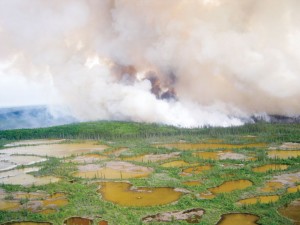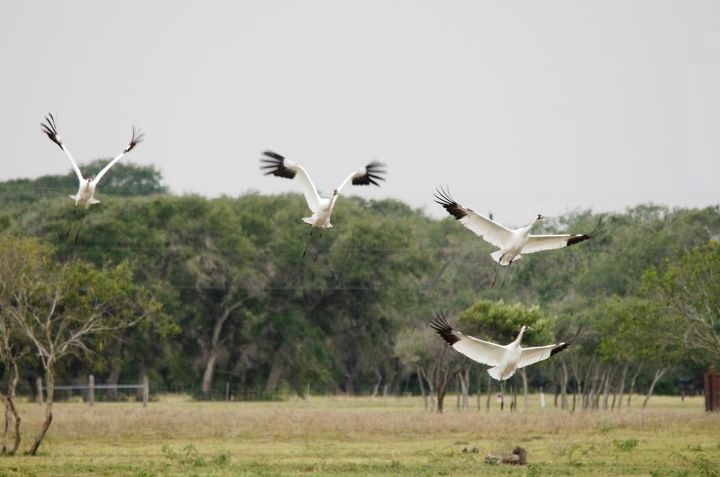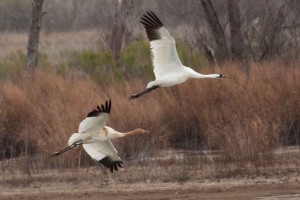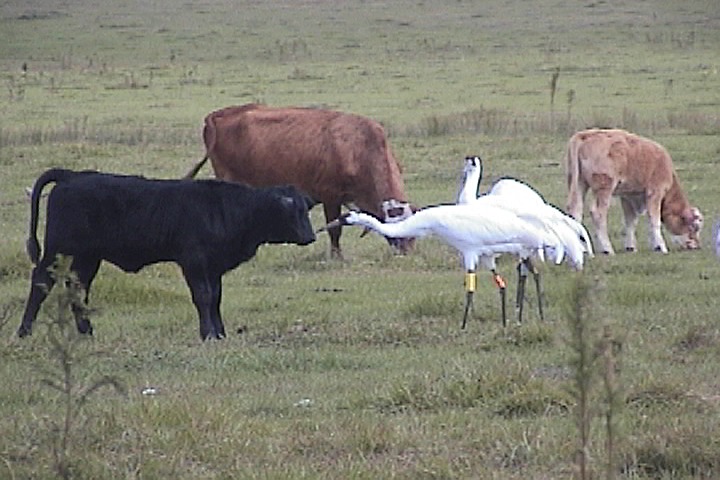Archive for the ‘Uncategorized’ Category
Wanted: Volunteers
September 23, 2014The Whooping Crane Conservation Association is currently seeking interested people to fill upcoming vacancies on our Executive. All executive positions, including those of the Trustees, are volunteer positions with no remuneration.
Secretary
We are seeking a person with organizational skills who is interested in becoming the secretary of the WCCA. The secretary is reponsible for keeping track of the membership information and donations. Proficiency with Microsoft ACCESS an asset.
Newsletter Editor
We are seeking a person with writing and organizational skills to put together our newsletter “Grus Americana”. The editor assembles articles of significance and then uses word processing software to form a newsletter. Proficiency with Microsoft Word or other word processing software an asset.
If you are interested in either of these positions, please use the Contact WCCA page. Thanks for your interest.
Salt Mountain burns as Mother Nature has her way
June 18, 2013by Don Jaque – Northern Journal, Fort Smith, Canada— June 10, 2013 at 6:32 PM
Photo: ENR NWT – The fire on top of Salt Mountain approximately 30 km west of Fort Smith grows to 1,100 hectares on Wednesday evening due to a cold cell and gusting winds that sent embers across the highway out of Wood Buffalo National Park.
For the second time in less than 11 months, a major campaign fire on Salt Mountain within 35 km of Fort Smith brought that community to a high state of alert, followed by relief after it was expertly controlled.
Last summer in late July, a multi-jurisdictional fire that started in Wood Buffalo National Park involved Alberta, NWT and national park resources in a campaign fire pushed by wind. Fire crews managed to corral it just as it threatened to cross Hwy 5 and take out the power lines from Taltson Dam that serve Fort Resolution, Enterprise and Hay River and potentially even turn towards Fort Smith. The fire was contained right at the highway with textbook-like precision.
The current fire started June 1 due to lightning in the park, burning slightly southwest of the 2012 burn, just south of Hwy 5. Over several days, Parks Canada crews from Wood Buffalo and three other national parks worked the fire on the ground, assisted by choppers with buckets and tankers of retardant from Alberta and the NWT.
On the night of June 3, the fire grew dramatically overnight. Crews performed a successful burnout operation along the highway to clean out fuels it might feed on if it turned that way to cut off the road and even burn the power lines. It was well contained and under control at that point.
Mother Nature decided to trump all that, however. On June 5, the weather changed and a cold front moved in, generating high winds from the south. By the afternoon, the fire had jumped the highway.
Photo: Patrick Pennycook – A GNWT water bomber heads through a thick cloud of smoke during control efforts on Wednesday evening.
“A spot inside the fire flared up and embers travelled across Hwy 5,” commented Jean Morin, fire program manager for Wood Buffalo National Park. He said the embers flew nearly a kilometre from well inside the fire, over the burnout, and started a new fire on the north side of the highway. It moved quickly.
“With the wind, the spread of the fire was very fast,” Morin said.
He said they bucketed the fire with the Parks Canada choppers and the NWT government called in air tankers to lay down retardant. The fire got into pine and spruce forest along the road to the Foxholes Prairies, producing a massive smoke column in the afternoon sky.
The fire then became an NWT challenge and crews from Fort Providence, Fort Liard, Inuvik and Hay River joined Fort Smith crews on the ground and hit it hard. Retardant lines were laid down by air tankers to protect the nearby settlement of Salt River. Five bulldozers were contracted to create a fire guard that protected both Salt River and the Foxholes Prairies where several pair of whooping cranes nest.
In the middle of the rampaging wildfire was an encampment of heavy equipment belonging to Aurora College, sitting in a gravel quarry near the Foxholes road where the college runs on-site training for a Thebacha Campus Heavy Equipment Operator course. College staff were forced to abandon the work site as soon as news came of the fast moving fire. There was fear all that expensive equipment might be lost.
Fortunately, all equipment survived unscathed. The Caterpillar tractors, loader and excavator were parked in the centre of a large gravel pit and the fire burned around and past it.
Cool weather subsequently helped the firefighters’ cause and with rain June 6, the blaze, after six action-packed days, was finally brought under control.
Louisiana Whooping Cranes Scouting Around
June 11, 2013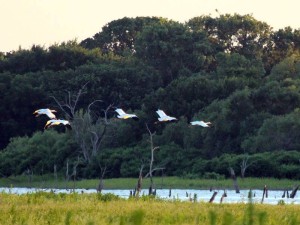 Latest report from Texas Whooper Watch regarding the two Louisiana Whooping Cranes that have been spending the past few weeks at a lake in Wise County Lake, Texas.
Latest report from Texas Whooper Watch regarding the two Louisiana Whooping Cranes that have been spending the past few weeks at a lake in Wise County Lake, Texas.
“Wise County whooper duo update – On Friday, June 7, the two whoopers that had been at Lake Ray Hubbard for over five weeks departed. GPS tracking points showed that they moved west and then northeast. The last reported coordinate was on a farm pond in Wise County on Sunday, June 9. We will keep you posted if this duo seems to linger at a location again.”
On June 6th, Texas Whooper Watch had an interesting Whooping Crane sighting. “Another interesting whooper sighting in Texas: A group of five yearling whooping cranes from the Louisiana reintroduced population have wandered into East Texas, in Polk County. Thus far we do not really know what habitats they are associated with, and they may move through the area rapidly. We’ll keep you updated!”
Report from June 10th: “Fenton 5” update – The five Louisiana whooping cranes that moved to Polk County last week have continued to move. We have not had any sightings “on the ground,” but the GPS telemetry data show that the group moved north to another lake as of Sunday, June 9. This restless group may continue to move, or might find a site to linger, so please feel free to let other wildlife watchers know that we are interested in sightings. Thanks!”
Texas Whooper Watch also reports: “Chris Jackson, who writes a blog, http://dfwurbanwildlife.com about DFW urban wildlife (and who helped monitor the Lake Ray Hubbard duo), got a chance to check out the “Fenton 5″ at another lake Monday evening, June 10. Here are some of his notes: ”All five Whoopers present and accounted for tonight. They ranged far and wide on the flood plain while I was there (walking and flying between locations). I was on site for about an hour.”
WCCA wishes to thank the Texas Whooper Watch and to Chris Jackson of DFW Urban Wildlife for the updates. Photo courtesy Chris Jackson
All Whooping Cranes Migrating To Canada
April 27, 2012- By: Chester McConnell, Whooping Crane Conservation Association
Whooping Cranes on Aransas and Private Lands
March 1, 2012Whooping crane aerial census surveys were completed a second time on Aransas Refuge in February. But analysis of the information is not yet complete. According to refuge officials the February aerial survey has had some challenges due to weather but they are continuing their efforts. The updated census information will be posted on the website as soon as it becomes available. Meanwhile the interested public must rely on the January survey information that indicated the population of cranes to be 245 individuals. Aransas officials caution that this number does not reflect whooping cranes outside the survey area, including those that have dispersed. Whooping crane biologist and many thousands of whooper followers have been hoping for a total population count of 300 this year.
The unusual warm weather and extreme drought conditions in Texas are believed to be a primary cause for the dispersal of whooping cranes this year. Normally the birds remain mostly on Aransas National Wildlife Refuge during winter months with a few moving to nearby suitable locations. This year, however the whoopers are ranging further out from the refuge with some as far north as Nebraska. Citizen observation reports made to the Whooping Crane Conservation Association detected whoopers in Nebraska, Kansas, Oklahoma and eight counties in Texas.
- Figure 1. Whooping cranesmaking use on private land in Texas.
Some good news is that, as of February 29, the precipitation totals for Aransas, TX are 3.75 inches. Also, heavy rains north of the Aransas Refuge brought much fresh water downstream to the bays and estuaries near the refuge. Salinity levels in San Antonio Bay are recorded as 20.4 parts per thousand. Salinity levels have dropped due to recent freshwater inflows from rain in Central Texas, as well as localized rainfall.
Since the last Aransas Refuge update, the refuge has conducted additional prescribed burns bringing the total to 10,852 acres of habitat. The whooping cranes have been observed eating the roasted acorns and other food sources. There are still approximately 1,110 acres planned for the remaining whooping crane season. The refuge had originally hoped to burn approximately 14,200 acres but weather conditions prevented firefighters from safely and effectively conducting the prescribed burns to help alleviate low food sources for the cranes.
209 Whooping Cranes Counted on Aransas NWR
February 3, 2012by Whooping Crane Conservation Association based on Aransas NWR report
Aerial surveys of the whooping crane population wintering on the Aransas National Wildlife Refuge were performed by U.S. Fish and Wildlife Service biologists last week. Refuge biologists have just completed their analysis of the census data and made their findings available. Three aerial surveys were conducted. A survey on January 26th was cut short due to high winds. Surveys conducted on January 27th and 29th were approximately 4 1/2 hours and each systematically searched Matagorda Island, San Jose Island, Blackjack Peninsula, Lamar Peninsula, Dewberry Island, and Welder Flats. Conditions for surveying were most favorable on January 29th, when observers detected 193 whooping cranes. Of the 193 cranes, 125 were white plumage birds, 23 were juvenile birds, and 3 were undistinguished.
The numbers do not represent a complete “census” of birds in the surveyed area, but will provide biologists a means to estimate the whooping crane population size. It is possible that some of the whoopers on the refuge were not detected by the observers. Analysis of these data is ongoing.
At least 16 additional Aransas-Wood Buffalo population of whooping cranes are currently residing outside of the typical wintering area, as far away as Nebraska. Based on the available data, 209 whoopers have been accounted for. The next survey flight will be scheduled for mid-February.
Approximately 5% of whooping cranes detected on the 27th and 29th were found using man-made freshwater sources, such as stock ponds and windmills. Cranes were using both upland and marsh communities. They are naturally supplementing their own food sources by wintering around freshwater lakes.
Refuge personnel continue to help alleviate the low food resources by adding to the prescribed burn totals. This winter the refuge has burned 8,095 acres of habitat that have recorded whooping crane usage. Biologists observed the whooping cranes eating roasted acorns and are seeing continued use. There are still an additional 6,129 acres planned to be burn for the remaining whooping crane season.
Many people have inquired whether the refuge plans to implement a supplemental feeding program for whooping cranes this winter. At this time, refuge officials are concerned about the negative impacts of supplemental feeding. Previous efforts to supplemental feed were not considered successful as only a small portion of the birds actually fed on the shelled corn.
Whooping cranes are territorial and do not naturally gather together to feed. Encouraging them to do so changes their natural behavior; it also creates greater opportunities to transmit diseases, parasites, and makes them more vulnerable to predators. Furthermore, when left out in warm and moist environments, like coastal marsh areas, corn can grow Aspergillis molds. Aflatoxins, which are produced by the molds, can be lethal to whooping cranes and other wildlife. Where whooping cranes may be present, landowners should be aware of the risks that aflatoxins pose. If corn is being be used for feeding other wildlife in areas where whooping cranes may be present, U.S. Fish and Wildlife Service scientists highly recommend purchasing aflatoxin-free corn.
Aransas National Wildlife Refuge has received 0.84 inches of precipitation for the month of January. Central Texas has been fortunate to receive some much needed rainfall recently and the water has raised the Guadalupe River to above flood stage levels from Jan 28th- Jan 31st. This river flows into the San Antonio Bay and the flush of freshwater is expected to further decrease salinity levels. Currently, salinity levels are reported to be 23.2 parts per thousand (ppt) compared to 35.3ppt on December 14, 2011.
January 24th data from Texas Parks and Wildlife Department indicates that samples taken in the San Antonio, East Matagorda, and Espiritu bays were free of red tide. It
is still persisting in some of the surrounding bays but in very low concentrations.
Aransas Refuge officials reported that a second radioed whooping crane chick has died this winter since their last report. The carcass has been sent off for testing and we are awaiting results.
Texas Coast and Whooper Law Suit
January 13, 2012Texas Coastal Update 2011
This summary of Jim Blackburn’s newsletter provides an oversight of several issues concerning the bays and estuaries on the Texas coast and their link to whooping cranes. Hopefully you enjoy this update as well as the poems that are now required reading at the end.
Whooping Crane Litigation
Wow. I just finished a two week trial before Judge Janis Graham Jack in federal District Court in Corpus Christi, and I am still somewhat in a daze. It was the experience and event of a lifetime. I felt like I had been learning and practicing for thirty years for this case. I represent The Aransas Project (TAP), a non-profit group formed to protect San Antonio and Aransas Bays in an attempt to secure freshwater inflows for this important estuary. TAP filed suit against the Commissioners and the Executive Director of the Texas Commission on Environmental Quality (TCEQ) and the South Texas Watermaster for violating the federal Endangered Species Act. We alleged that the TCEQ allowed so much water to be removed from the San Antonio and Guadalupe Rivers that the bay salinity was changed beyond what the drought would cause, leading to less food supply for the Whooping Cranes, altering the drinking water supply of the whooping cranes and ultimately causing the death of 23 cranes during the winter of 2008-2009. The trial lasted for about two weeks.
Fresh off the whooping crane litigation, I want to engage in a rambling discourse about Texas water law, an archaic system that must be changed if we are to ever save our bays and estuaries. Texas water law and practice killed Nueces Bay. Of that there is no doubt. Nueces Bay at one time was a flourishing estuary. It is now officially classified by the Bay and Basin Expert Science Team (BBEST) formed under SB 3, as unsound due to inflow alteration, whereas every other estuary on the coast is still considered to be ecologically sound. We have proven that we can kill an estuary. Now is the time to start saving some.
Texas surface water is owned by the State of Texas. Use of state water is authorized by Certificates of Adjudication and permits and by statutory exemption. Although we the people own the water, we don’t act like it. We as citizens need to become as concerned about the protection of our public property as we are about protection of private property.
To read Jim Blackburn’s entire newsletter click on the following file: https://whoopingcrane.com/wp-content/uploads/2012/01/Coastal-Update-2011-Whoper-Law-Suit-Blackburn.docx
Group Can Keep Fighting for Whooping Crane
December 9, 2011
Thursday, December 08, 2011Last Update: 3:40 PM PT
Group Can Keep Fighting for Whooping Crane
CORPUS CHRISTI, Texas
(CN) – A federal judge refused to rule on claims that Texas is threatening the existence of whooping cranes by allowing diversion of the birds’ freshwater source. In a March 2010 federal complaint, The Aransas Project (TAP) claimed that mismanagement in the Texas Commission on Environmental Quality and the South Texas Watermaster has brought the whooping crane to the brink of extinction, with 23 birds dying in the harsh 2008-09 winter.
By the end of the season, the Guadalupe Basin crane population had allegedly declined to 247. TAP links the loss of birds in the basin to the diversion of freshwater from the Guadalupe and San Antonio Rivers.
Both sides, as well as intervening defendant Guadalupe-Blanco River Authority, moved for summary judgment, but Senior U.S. District Judge Janis Graham Jack roundly rejected the motions Monday.
Though Jack refused to grant TAP’s motion for partial summary judgment on standing, she also held that the environmentalists’ complaint survived its adversaries’ challenges. Jack devoted a section of her order to determining whether the commission could be held liable for water-diversion activity conducted by third parties. “Plaintiff has alleged that the TCEQ defendants are responsible for water permitting and water diversions from the waterways at issue, and the increased diversions have left less water for the cranes, resulting in a taking,” Jack wrote, abbreviating the commission defendant’s name. “This type of causation is sufficient for an ESA suit challenging governmental regulation,” she concluded.
Regulatory agencies like the TCEQ can be held responsible for harming an endangered species through its regulations, according to the 45-page order. “The court recognizes that ‘a governmental third party pursuant to whose
authority an actor directly exacts a taking of an endangered species may be deemed to have violated the provisions of the ESA,’ specifically the ‘taking’ provision in ESA Section 9,” Jack wrote.”The court concludes that plaintiff provides enough evidence of a ‘taking’ of whooping cranes, both in terms of deaths and non-fatal harm, such as malnourishment, to survive a motion for summary judgment,” she added.
The judge concluded by disagreeing that the U.S. Supreme Court’s holding in Burford v. Sun Oil required her to dismiss. That 1943 decision blocked a challenge to oil drilling that the Texas Railroad Commission had approved.
Whooping crane pokes calf on nose
November 21, 2011**** Photo by Marty Folk ****
Whooping cranes, like all wild creatures, must defend themselves occasionally. The photo shows a whooper poking a calf on its nose to make it back off. During night time, whooping cranes try to roost in a shallow river or lake to help protect themselves from predators like coyotes and bob cats. During day time they can hold off some predators with their sharp beak. Or they can make high jumps or fly.
Whooping Crane Conservation Association www.whoopingcrane.com
Whooping Cranes Spotted Along Migratory Route
November 5, 2011By: Chester McConnell, Whooping Crane Conservation Association
The fall migration of whooping cranes is at its peak according to the Whooping
Crane Conservation Association. Of the approximate 300 whooping cranes in the
total original wild flock, 128 have been positively spotted from North Dakota
to Texas. The whoopers have followed this migratory path for thousands of
years. Trained, professional wildlife personnel from federal and state agencies
and private conservation groups monitor the migration route to keep check on
the cranes.
Martha C. Tacha, U.S. Fish and Wildlife Service, Grand Island,
Nebraska advises that, there is “Lots of activity in the flyway
since the last update a week ago.” Tacha stated, “I’m sure the weather
front that moved through the Flyway recently will move the
cranes some more! The cranes are still strung from North Dakota to Aransas,
Texas but there are currently more cranes in Kansas and Oklahoma than last
week.”
Ms. Tacha informed the Whooping Crane Conservation Association
of one disturbing observation. She advised that at least two
whooping crane families have lost a parent. According to
Tacha, “The loss of breeding adults from 2 pairs is unfortunate; particularly
going into what may be a difficult winter at Aransas.”
A reassuring observation was also made by the trained spotters.
They detected the apparent presence of at least 5 whooping
crane families with twins. At first there was some doubt about the count
because it was unexpected. Yet 5 twin pairs were detected and there is little
chance the same cranes could have been counted twice due to the distance
between the observations. The Whooping Crane Conservation Association will
continue to monitor the recent discoveries and provide more details as we learn
about them.
